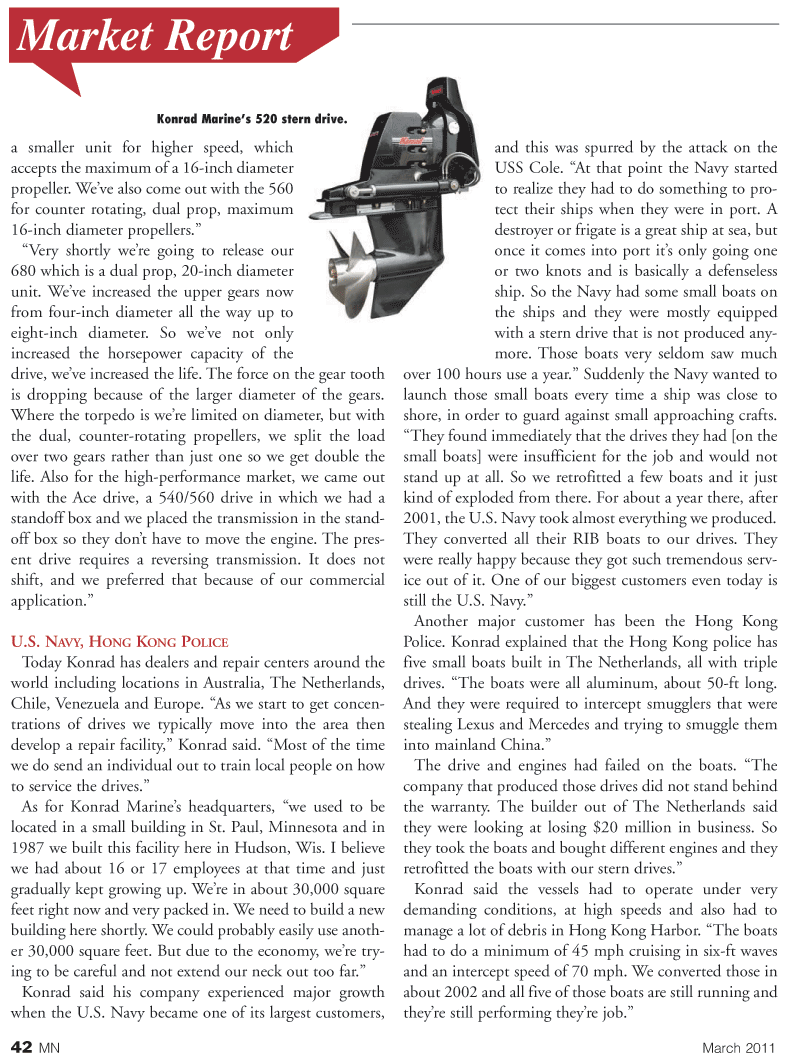
Page 42: of Marine News Magazine (March 2011)
Marine Training & Education Edition
Read this page in Pdf, Flash or Html5 edition of March 2011 Marine News Magazine
42 MN March 2011
Market Report a smaller unit for higher speed, which accepts the maximum of a 16-inch diameter propeller. We’ve also come out with the 560 for counter rotating, dual prop, maximum 16-inch diameter propellers.” “Very shortly we’re going to release our 680 which is a dual prop, 20-inch diameter unit. We’ve increased the upper gears now from four-inch diameter all the way up to eight-inch diameter. So we’ve not only increased the horsepower capacity of the drive, we’ve increased the life. The force on the gear tooth is dropping because of the larger diameter of the gears.
Where the torpedo is we’re limited on diameter, but with the dual, counter-rotating propellers, we split the load over two gears rather than just one so we get double the life. Also for the high-performance market, we came out with the Ace drive, a 540/560 drive in which we had a standoff box and we placed the transmission in the stand- off box so they don’t have to move the engine. The pres- ent drive requires a reversing transmission. It does not shift, and we preferred that because of our commercial application.”
U.S. NAVY, HONG KONG POLICE
Today Konrad has dealers and repair centers around the world including locations in Australia, The Netherlands,
Chile, Venezuela and Europe. “As we start to get concen- trations of drives we typically move into the area then develop a repair facility,” Konrad said. “Most of the time we do send an individual out to train local people on how to service the drives.”
As for Konrad Marine’s headquarters, “we used to be located in a small building in St. Paul, Minnesota and in 1987 we built this facility here in Hudson, Wis. I believe we had about 16 or 17 employees at that time and just gradually kept growing up. We’re in about 30,000 square feet right now and very packed in. We need to build a new building here shortly. We could probably easily use anoth- er 30,000 square feet. But due to the economy, we’re try- ing to be careful and not extend our neck out too far.”
Konrad said his company experienced major growth when the U.S. Navy became one of its largest customers, and this was spurred by the attack on the
USS Cole. “At that point the Navy started to realize they had to do something to pro- tect their ships when they were in port. A destroyer or frigate is a great ship at sea, but once it comes into port it’s only going one or two knots and is basically a defenseless ship. So the Navy had some small boats on the ships and they were mostly equipped with a stern drive that is not produced any- more. Those boats very seldom saw much over 100 hours use a year.” Suddenly the Navy wanted to launch those small boats every time a ship was close to shore, in order to guard against small approaching crafts. “They found immediately that the drives they had [on the small boats] were insufficient for the job and would not stand up at all. So we retrofitted a few boats and it just kind of exploded from there. For about a year there, after 2001, the U.S. Navy took almost everything we produced.
They converted all their RIB boats to our drives. They were really happy because they got such tremendous serv- ice out of it. One of our biggest customers even today is still the U.S. Navy.”
Another major customer has been the Hong Kong
Police. Konrad explained that the Hong Kong police has five small boats built in The Netherlands, all with triple drives. “The boats were all aluminum, about 50-ft long.
And they were required to intercept smugglers that were stealing Lexus and Mercedes and trying to smuggle them into mainland China.”
The drive and engines had failed on the boats. “The company that produced those drives did not stand behind the warranty. The builder out of The Netherlands said they were looking at losing $20 million in business. So they took the boats and bought different engines and they retrofitted the boats with our stern drives.”
Konrad said the vessels had to operate under very demanding conditions, at high speeds and also had to manage a lot of debris in Hong Kong Harbor. “The boats had to do a minimum of 45 mph cruising in six-ft waves and an intercept speed of 70 mph. We converted those in about 2002 and all five of those boats are still running and they’re still performing they’re job.”
Konrad Marine’s 520 stern drive.

 41
41

 43
43
